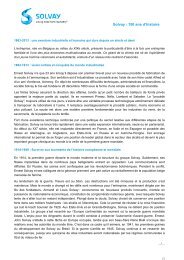Pharmaceuticals Sector - Solvay
Pharmaceuticals Sector - Solvay
Pharmaceuticals Sector - Solvay
You also want an ePaper? Increase the reach of your titles
YUMPU automatically turns print PDFs into web optimized ePapers that Google loves.
36<br />
“ 30 million tonnes of PVC<br />
were consumed worldwide<br />
in 2005.”<br />
<strong>Solvay</strong> Global Annual Report 2005<br />
Vinyls<br />
(Polyvinyl Chlorides<br />
(PVC), performance<br />
compounds and Pipelife,<br />
a 50/50 joint venture with<br />
Wienerberger in pipes<br />
and fi ttings).<br />
30 million tonnes of PVC were<br />
consumed worldwide in 2005, up<br />
3% from 2004. China again stood<br />
out with growth of around 10%,<br />
consuming almost 7.5 million tonnes<br />
in 2005, more than the whole of<br />
Western Europe.<br />
PVC prices fl uctuated signifi cantly<br />
during 2005, refl ecting both the<br />
supply/demand balance and costs<br />
of raw materials and utilities.<br />
After peaking at the end of 2004,<br />
PVC prices reached a low in<br />
summer 2005 before beginning to<br />
recover signifi cantly from September<br />
onwards, owing to major production<br />
losses in the USA from Hurricanes<br />
Katrina and Rita.<br />
Vinyls margins, excellent during the<br />
fi rst quarter of 2005, deteriorated<br />
signifi cantly during the second<br />
quarter, recovering later from<br />
September onwards. Average<br />
results for Vinyls for the year as a<br />
whole remained at an excellent level,<br />
and above those of 2004.<br />
In a highly competitive European<br />
situation, SolVin (owned 75% by<br />
<strong>Solvay</strong> and 25% by BASF) used the<br />
reliability of its plants and its high<br />
degree of raw materials integration<br />
to maximize production. SolVin<br />
continued its quest for competitiveness<br />
by closing down its modestsized<br />
Ludwigshafen (Germany) unit<br />
at the end of 2005, and bringing<br />
on line new capacities at its<br />
Jemeppe (Belgium) and Rheinberg<br />
(Germany) sites. SolVin’s profi ts<br />
fully refl ect its excellent competitiveness.<br />
Eastern Europe also contributed<br />
very signifi cantly to demand for<br />
PVC made in Western Europe,<br />
with strongly rising imports of<br />
semi-fi nished products (profi les,<br />
fl oor covering, piping and fi ttings)<br />
and a shortage of PVC resins in the<br />
also fast-growing Russian market.<br />
The fi fth report of Vinyl 2010,<br />
the voluntary accord of the PVC<br />
industry in which <strong>Solvay</strong> plays an<br />
active part, was published in<br />
May 2005. It shows that the<br />
achievement of objectives for<br />
recycling levels is continuing to<br />
meet the plan. The VINYLOOP ®<br />
unit at Ferrara (Italy) continues to<br />
develop in terms of production<br />
levels, new technology and<br />
applications for recycled PVC,<br />
despite a European economic<br />
environment that remains<br />
unattractive for recycling projects.<br />
During 2005 SolVin continued its<br />
feasibility study for an integrated<br />
world-scale unit in Russia.<br />
Plastics <strong>Sector</strong><br />
This would enable it to consolidate<br />
its leadership in Europe and to pursue<br />
its geographic diversifi cation<br />
towards Russia, where demand for<br />
PVC is rising sharply, and which<br />
offers competitive advantages in<br />
terms of raw materials. The feasibility<br />
study should reach the decision<br />
stage in 2006.<br />
In Mercosur, <strong>Solvay</strong> Indupa<br />
a listed Argentine company in<br />
which <strong>Solvay</strong> has a majority<br />
shareholding, also enjoyed very<br />
favourable conditions on the<br />
Argentine market. Demand on the<br />
Brazilian market, on the contrary,<br />
suffered from prohibitive interest<br />
rates, which placed a severe rein<br />
on construction investment.<br />
The excellent competitiveness<br />
and the good operating qualities<br />
of the Argentine and Brazilian<br />
installations are key factors which<br />
again generated an excellent result.


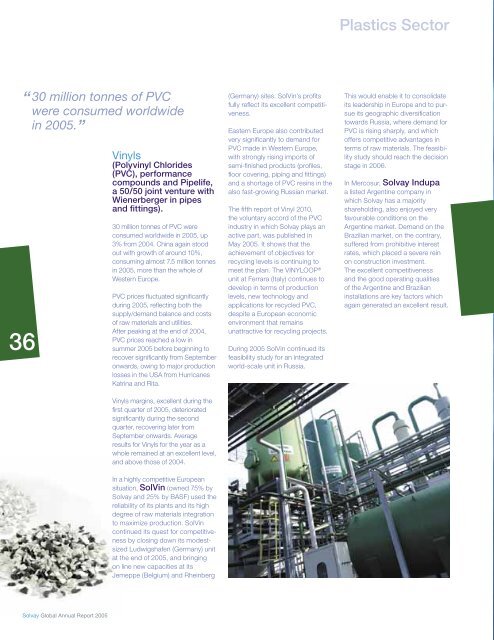

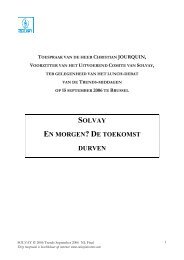
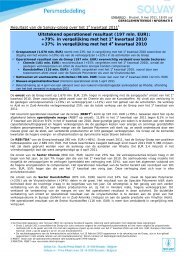

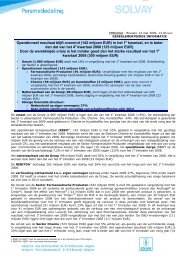
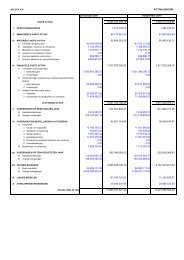


![PROC.1 [LETTRE] - Solvay](https://img.yumpu.com/16585746/1/184x260/proc1-lettre-solvay.jpg?quality=85)
